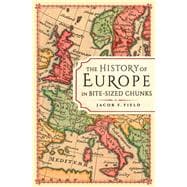An accessible and succinct account of the story of Europe from its ancient foundations to the twenty-first century, The History of Europe in Bite-sized Chunks details the events, personalities, ideas and disasters that have shaped the European continent.
The book is broken down into six easily digestible chapters: Classical Antiquity (2600 BCE to 600 CE); Medieval (600-1500); Reform and Enlightenment (1500-1780); Age of Revolutions (1780-1914); the Wars (1914-45); and the Making of Contemporary Europe (1945 to present).
It begins with the first ancient culture to emerge in Europe: the Minoans. It then proceeds chronologically to the present day, taking in not just significant historical events but also overarching social, technological and cultural trends and their impact.
Throughout the book there are mini-biographies of notable individuals (such as Julius Caesar, Catherine the Great and Napoleon Bonaparte) who have been most significant in European history. It is also packed with amazing facts, details and maps that will give the reader a vivid understanding of Europe’s past.








